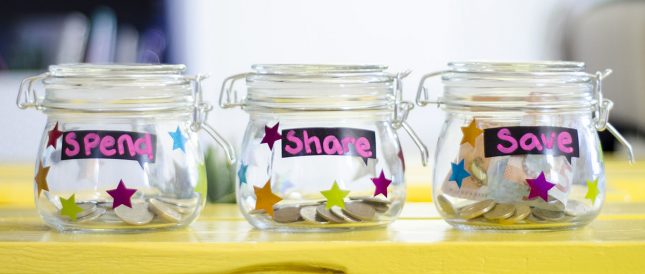Teaching your kids money skills from a young age could be the difference between them living on a money treadmill, and living a life of abundance. The spend, save, share jars concept has to be the best system I know for teaching young children money management.
Why teach kids money skills?
Teaching children how to save and spend money consciously, then how to invest money for growth, and finally how money energy ‘flows’ will change their lives. Pure and simple.
We’ll take a look at all of these topics over the next while. But the best place to start is really simple ideas, about saving and spending.
By teaching young children, visually, that money has a form, that money ‘grows’, and that spending money means it’s gone, we’ll set them up with a good understanding for future learning.
Lots of families give their kids piggy banks or money boxes, their children receive pocket money, and they may even have a savings account at the bank. But none of this teaches money skills.
Our children need to understand the ‘function’ and ‘value’ of money. They need to understand the ideas behind savings and interest, earning and spending, the effect of time (both appreciation, and devaluation!), the magic of compound interest, and the power of wealth (both good and evil!).
None of this can be learnt from a piggy bank!
Children that learn good money skills from a young age, grow up to be adults that value money, and know how to save and invest to accumulate wealth.
A paper on household wealth for the De Nederlandsche Bank in Holland showed that people with more financial knowledge were:
- more likely to invest in the stock market, and
- more likely to plan and save for their retirement
The research shows the difference in households in the 25th and 75th percentile of the ‘advanced financial literacy’ index is an extra €80,000 of retirement savings. That’s a LOT more wealth for retirement!
We are literally teaching our kids to be rich.
So, let’s start out by taking a look at the simple 3 jar savings system. Where did this idea come from?
The Jewish 5 Jar System
The 3 jar saving system is loosely based on the Jewish system of money management.
Jewish families are noted at being very good at wealth accumulation. And, importantly, Jewish families have always been very good at passing these skills on to their children.
If you need any proof that teaching money skills to kids will make a difference to their lives, think about this for a moment:
100 of the 400 billionaires on the Forbes rich list are of Jewish descent.
Teaching children about how to save and spend money consciously and how to share their money with others, clearly works.
The 5 jar system isn’t too complicated. The main difference between the Jewish jars and the 3 jar technique is the inclusion of a jar for tithing, and a jar for investing.
It looks like this, for every $10 earned:
$1 is for tithing
$1 is for giving
$1 is for saving
$2 for investing
$5 for spending

If you’re a religious family, you might want to include a tithing jar. If you’re not a religious family, then the sharing jar should suffice for this purpose. The learning ‘that growing our community by sharing our resources with others in need’ is broadly similar.
The investing jar is a useful idea, but probably for older kids, from about the age of 8 and up. Younger children just need to understand that the savings jar is for ‘growing’ their money. Learning how the money grows can come later.
That’s why we advocate for the much simple 3 jar saving system. Otherwise know as the Spend, Save, Share jars.
Spend, Save, Share Jars – The 3 jar saving system
Spend, save, share jars are such a cool way of teaching money skills to kids.
These are also sometimes called the Spend, Save, Give jars. But we prefer ‘share’, as we’re not giving our money away here. Rather we’re sharing our resources with those in need in our wider community. In this way we’re growing our whole community for the better.
So let’s take a look at each jar, in turn, and consider what the learning behind them is.
Remember that the jars are a teaching tool. Our kids need to understand the purpose, and principle, behind each jar. They’re not just sticking coins in jars here!
By understanding how the ‘system’ works, we’re actually teaching our kids that they need a ‘system’ to make money work for them.
Hopefully this key understanding will translate into family budgeting skills, debt management skills and investing skills in the future.
Spend
The spending jar is for the money kids can spend on themselves, their family, or others.
This is the jar for buying themselves a weekly treat. Or maybe for having spending money at their school gala. Or perhaps for buying friends and family birthday presents.
It’s also the jar where kids save for short term goals. This might be new bearings for their scooter, a new gaming app, or a magazine subscription, whatever they’re in to.
The principle behind the spending jar is that we allocate a portion of our earnings to spend on short term needs, and medium term wants.
Save
The savings jar is where kids put their money over the longer term to ‘grow’.
Because we’re not using a bank account here, there won’t be any actual interest accruing. But you can always reinforce the lesson here by dropping a few extra bucks in the jar every now and then. Or you could remove the savings portion every month and pop it into a kid’s savings account at the bank.
It’s important that you child doesn’t touch the savings jar for the long term. One effective way to do this is to have them save up for a long term goal. This could be a new scooter, or game, or even spending money for a family holiday.
Just make sure the long term is long enough. For younger kids that might be just a few months. For kids 8 and up, you want the long term to be at least a year or more.
The principle here is that we allocate a portion of our earnings to save for long term wants. And that if we ‘invest’ our money in a savings account, interest will be added making our savings grow even faster.
Share
The sharing jar, believe it or not, is often the kids favourite jar overall. This is the jar for sharing our money with our community.
How you choose what ‘share’ looks like is up to your and your child. And this might be determined by your religious beliefs, charities you choose to support as a family, or what you define as community.
Some examples of sharing include: charitable donations, school fund-raising activities, supporting a local charity (like you local toy library for example), church donations, buying toys for the children’s ward at your hospital, buying books and pens to send to charities overseas, supporting a family in need (perhaps a family at your child’s school going through a hard time), or even supporting your own family.
The principle here is there are people in our community (whether your own backyard, or the wider global one) in need. When we have more resources than we can consumer, we can help our community out by sharing what we have.
We don’t expect anything in return. But we do expect the people we help to ‘pay if forward‘ one day when they can. In this way, the whole community grows and prospers.
How to allocate your child’s earnings
The actual contribution your child makes to each jar will depend on how much they earn (from pocket money, a paper round, lemonade stand, etc.), and how big their savings goals are.
Here’s a couple of different allocation options to consider (in the order Spend, Save, Share):
1/3, 1/3, 1/3
40%, 40%, 20%
50%, 30%, 20%
70%, 20%, 10%
In terms of real life, the last 2 options might be closer to reality (after all, who really saves 40% of their income!). But the first option might be easy, and practical.
Depending on how much your child earns, it can be a little tricky to split the coins across 3 jars. If you pay your child in multiples of 3, the 1/3 system works well, ie $9 a week can be split up into $3 in each jar. If your child earns in multiples of $5, the last 2 options might work better.
You can also have your child start their own budget plan. This way they can keep track of how much they’ve allocated to each jar. But this is an advanced technique, and better suited for children from 10 years and up.
Now that you know how to create the Spend, Save, Share Jars system, you’re well on your way to teaching your kids money skills. Skills that could make all the difference to their lives.
For more expert advice on family budgeting, and kid’s money skills, check out our Family finances section.








